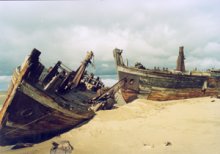
OLEN VAPAA
"Vapaus on täydellinen! Voimme mennä mihin haluamme... ja tehdä mitä haluamme..." toteaa haastateltava Pestov .
 Shoinan kylä sijaitsee Arkangelista 60 km pohjoiseen. Ilmasto on kohtuuton: talvella kaamos, kesällä loputtomat meren rantauttamat hiekkapilvet peittävät kylän talot kattoihin saakka. Asuintalot kaivetaan esiin , ja julkisiin paikkoihin, kuten leipomoon tai postiin asukkaat ajavat erikoisvalmisteisilla moottoripyörillä - moottoripyörillä, joihin on asennettu kuorma-auton pyörät.
Shoinan kylä sijaitsee Arkangelista 60 km pohjoiseen. Ilmasto on kohtuuton: talvella kaamos, kesällä loputtomat meren rantauttamat hiekkapilvet peittävät kylän talot kattoihin saakka. Asuintalot kaivetaan esiin , ja julkisiin paikkoihin, kuten leipomoon tai postiin asukkaat ajavat erikoisvalmisteisilla moottoripyörillä - moottoripyörillä, joihin on asennettu kuorma-auton pyörät.
Dokumentti on kuvattu kesällä ja syksyllä. Talvella kylään on mahdoton päästä.
Shoinan kylässä on tällä hetkellä asukkaita nelisen sataa. Heistä kolmasosa eläkeläisiä. Viimeiset viisikymmentä vuotta Shoinan asukkaat ovat itse hallinneet itseään, vaikka nimellisesti neuvostotasavalta oli olemassa.
Lähin miliisi oli 300 kilometrin päässä ja kerran viidessä vuodessa vaaliuurna tuotiin paikalle helikopterilla. Perestroikan aikana valtion rooli väheni minimiin.
Tuulen viemää dokumentti herättää kysymyksen valtiollisesta vapaudesta - erityisesti Venäjällä. On kysymys vapaudesta, josta miljoonat venäläiset haaveilivat jo ennen maaorjuuden aikaa, mutta myös läpitunkevasta viehtymyksestä riippuvuuteen, joka sekin on olemassa jokaisessa venäläisessä.
Shoinan kylässä ei nyt vaikuta valtio, sen virkamiehet ja hallinto. Mutta millaisen tien valitsevat nämä vapauttaan rakastavat pomorit (= Vienan ja Barentsinmerenrannikon asukkat)? Vaikean ja vapaan elämän vai riippuvuuden ilman henkilökohtaista vastuuta ja aloitteellisuutta?
- Ohjaaja: Gennady Gorodny ja Andrei Osibov
- Tuotanto: Documentary Film School Studio, Venäjä ja Dokumenttiprojekti, 1999
In English In English In English
BLOWN IN WITH THE WIND
 This is a film about a Russian settlement Shoyna located 60 km to the north of Arkhangelsk on the western coast of the Kanin peninsula. The population (Russian White Sea coast-dwellers, one of whom was M. Lomosov, a prominent Russian scientist) amounts to some 400 people, a third of them being pensioners.
This is a film about a Russian settlement Shoyna located 60 km to the north of Arkhangelsk on the western coast of the Kanin peninsula. The population (Russian White Sea coast-dwellers, one of whom was M. Lomosov, a prominent Russian scientist) amounts to some 400 people, a third of them being pensioners.
The climatic conditions are: polar night - in winter, and endless sands brought by the sea and covering the settlement buildings up to the roofs - in summer. Dwelling places are dug out, as for the public buildings like the bakery or the post office - local people reach them by "truckeycycles", motorcycles with truck wheels.
In spite of nominal control of the Soviet/Russian authorities, for the last half a century the Shoyna people have been living by self-government principles. The nearest militiaman in 300 away; once every five years a ballot box is brought by helicopter.
With the advent of perestroika the role of the state came down to nothing. According to one of the film characters A. Pestov, "The freedom here is absolute! You can go wherever you want..and do whatever you want..".
The film is neither ethnological, nor political. Rather, it is metaphysical reflection:
- on the role the state in Russia
- on freedom longed for by millions of Russians from the time of serfdom
- on paradoxical reluctance to be free which lingers on in every Russian Person
- Directors: Gennady Gorodny amd Andrei Osibov
- Production: Documentary Film School Studio, Russia; TV2/Documentaries, 1999

Päivitys: 16.3.2000 U.E.